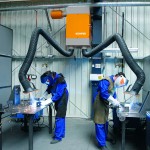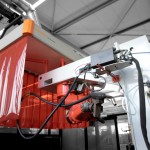Central extraction systems for welding fumes and cutting dust: 14 facts that matter
Are large quantities of welding fumes of cutting dust generated in production? Are there several workstations for production? Then central extraction systems for welding fumes and cutting dust are often the means of choice. Through their high efficiency, they ensure clean workshop air. When investing in a system, companies should not pay attention to the equipment’s features alone.
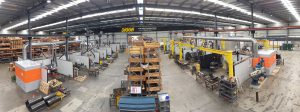 It is over 25 years since the first central extraction systems came onto the market. After mobile extraction solutions had already been established in the 1980s, the innovation of that period established a further developmental step in welding fume extraction. Collecting large quantities of hazardous material, even while operating automated cutting processes, was thus no longer a problem. Additionally, several workstations could be linked with only one system. The following fact summary shows what is really important for central extraction systems for welding fumes and cutting dust and where metal processors should pay attention when making an investment.
It is over 25 years since the first central extraction systems came onto the market. After mobile extraction solutions had already been established in the 1980s, the innovation of that period established a further developmental step in welding fume extraction. Collecting large quantities of hazardous material, even while operating automated cutting processes, was thus no longer a problem. Additionally, several workstations could be linked with only one system. The following fact summary shows what is really important for central extraction systems for welding fumes and cutting dust and where metal processors should pay attention when making an investment.
-
Central extraction systems for high operational requirements
If companies have high requirements for welding fume extraction or cutting dust collection, then central extraction systems are the state of the art. This necessity is due on the one hand to the high concentrations of generated hazardous material, and on the other to the number of workstations. Central extraction systems are particularly suited in operational environments such as, for examplewelding workshops, grinding mills, training centers and robotic lines.
-
Compatible with various different collection devices.
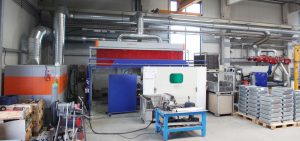 Central extraction systems are not just optimal for dealing with large quantities of welding fumes. They are also compatible with different collection devices. For this reason, companies can utilize them for different areas of application. With appropriate piping systems, they can be coupled with:
Central extraction systems are not just optimal for dealing with large quantities of welding fumes. They are also compatible with different collection devices. For this reason, companies can utilize them for different areas of application. With appropriate piping systems, they can be coupled with:
- Extraction arms and telescopic arms
- Welding and grinding tables
- Extraction tables for workshops
- Extraction hoods for robots, for example
-
Low energy consumption through automatic extraction power regulation
Central extraction systems should be equipped with automatic extraction power regulation. This ensures that the volume flow is generated according to the actual requirements. If, for example, only five of the ten workstations are in operation and hazardous material must be extracted from these sectors, the central extraction system regulates the power itself. In this way, the plant operator keeps running costs, energy costs and follow-up costs low.
-
The optimal filter material for central extraction systems
It is not just the collection of hazardous material that is fundamental for the effectiveness of an extraction system; the separation is equally as important. This is where the filter media come into play. In order to work efficiently with high concentrations of hazardous material, self-cleaning filter media are practical. Although systems that are thus equipped result in high acquisition costs, these are recouped very quickly due to their almost endless usability and low follow-up costs. Ideally media such as ePTFE filter membranes are used. (You can read how they function here.)
-
IFA Certification important for Cr/Ni welding
Those who wish to be on the safe side when procuring central extraction systems should take note of the W3 certification of the Institute for Occupational Safety and Health (IFA). If a central extraction systems complies with the requirements of the welding fumes class W3, the cleaned air may be recirculated even when extracting carcinogenic hazardous material, for example when welding chrome-nickel steels – in Germany at least when partially mixed with fresh air, while in some countries it may not be recirculated at all. Central extraction systems with W3 certification are thus the state-of-the-art for welding.
-
Energy-saving operation thanks to air recirculation
From a technical aspect alone, it is possible to lead the cleaned air out of the production hall. Operators of central extraction systems wish to reduce energy costs by reusing the cleaned air. Efficient central extraction systems should be capable of doing this. The already heated, but contaminated air is recirculated with the hall air after removal of hazardous dust – in the case of carcinogenic materials, however, this only occurs under certain conditions.
-
Low background noise for gentle operation
When purchasing central extraction systems, the operational noise level is an important factor. Central extraction systems should be as quiet as possible. The noise level of an efficient central extraction system today lies around a maximum of 65 dB(A). Thus there is no additional high-level noise source in the production.
-
Weatherproof version possible
A central extraction system can also be set up outside of production facilities. Thus not only is a source of noise automatically absent, it also saves space in the hall for metal processors.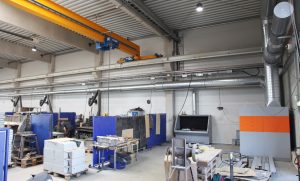 A weatherproof version of the system is a prerequisite for this. System operators can control outdoor central extraction systems from inside using an external operating panel.
A weatherproof version of the system is a prerequisite for this. System operators can control outdoor central extraction systems from inside using an external operating panel.
-
Intuitive control facilitates the operation of central extraction systems
Occupational safety procedures are secondary processes. Therefore it must be easy to operate central extraction systems. Intuitive user navigation is a must. Welding work is also made easier by the digitalization of the control system. As a result, central extraction systems can be controlled automatically if necessary. In order for a system to be remotely serviced by the manufacturer, additional provisions have to be made.
-
Permanent operation
Companies want to reduce downtimes in their processes as much as possible. What could be more annoying than having to interrupt your work because of a secondary process? The automatic, differential pressure-controlled filter cleaning process on effective central extraction systems ensures uninterrupted operation.
-
Measures against filter fires: The pre-separator extinguishes sparks
In order to set up central extraction systems safely, it is recommended to install an upstream spark pre-separator. This detects sparks and absorbs them before they reach the installation. In this way, system operators can prevent filter fires and associated system breakdowns.
-
Central extraction systems with safe waste disposal
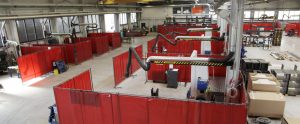 However, there is more to central extraction systems than just the extraction of welding fumes and filtration. Efficient installations ensure safe production air along the chain of hazardous materials. This is made possible by automatic dust removal. Central extraction systems should have a self-contained dust collection container that can be cleaned and made entirely free of any contamination.
However, there is more to central extraction systems than just the extraction of welding fumes and filtration. Efficient installations ensure safe production air along the chain of hazardous materials. This is made possible by automatic dust removal. Central extraction systems should have a self-contained dust collection container that can be cleaned and made entirely free of any contamination.
-
Planning of central extraction systems requires expert knowledge
Calculating the hall air and the necessary air flows requires expert knowledge. An over-dimensioned system can even cause economic damage to a company. Thus it is recommended to allow qualified extraction technology experts plan the installation of a central extraction system. With a variety of versions available in terms of performance, the extraction technology can be individually matched to the plant’s requirements.
-
Investment in extraction systems made easy
Extraction technology, and in particular central extraction systems, result in investment costs for metal processors. In order to absorb some of the costs, the Federal Office of Economics and Export Control (BAFA) offers attractive subsidies. Here energy efficiency concepts are of particular significance, as is provided in efficient extraction systems.




